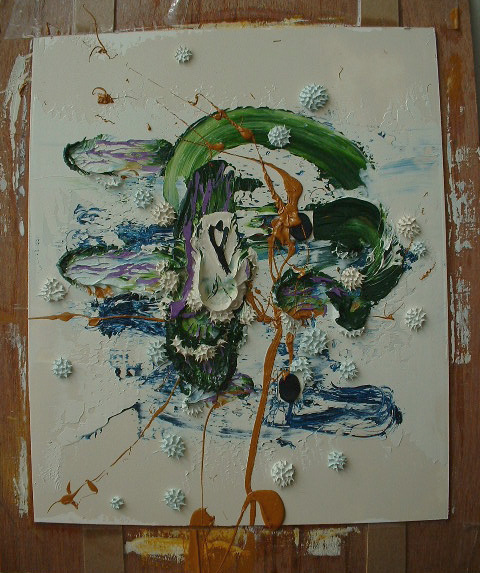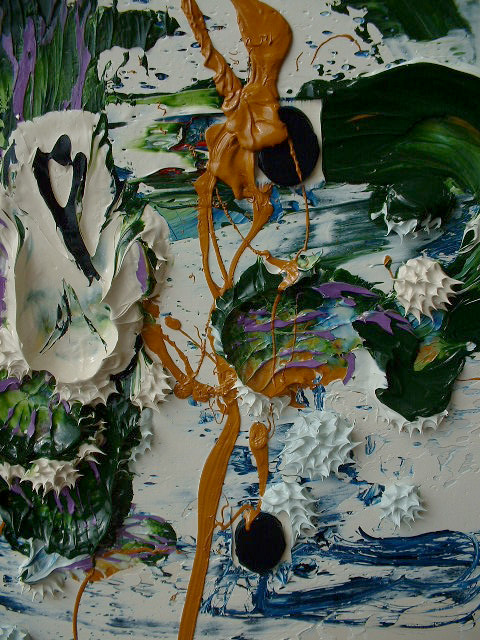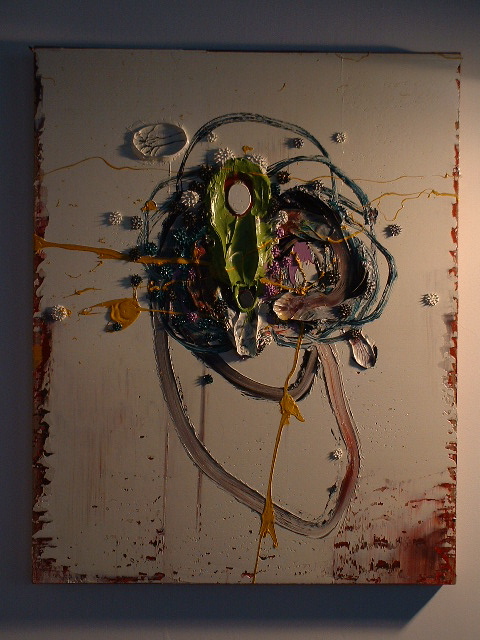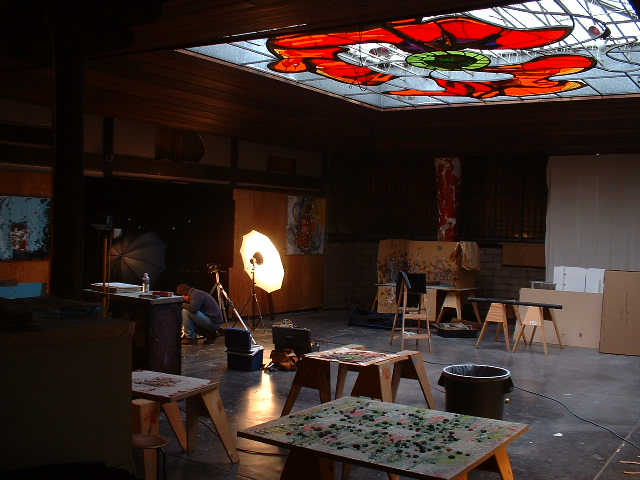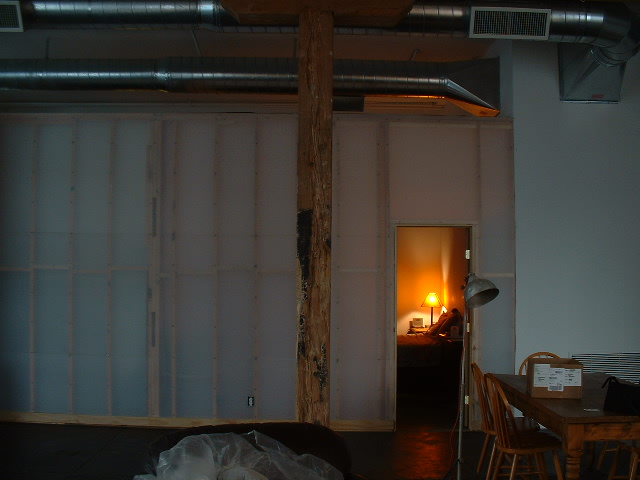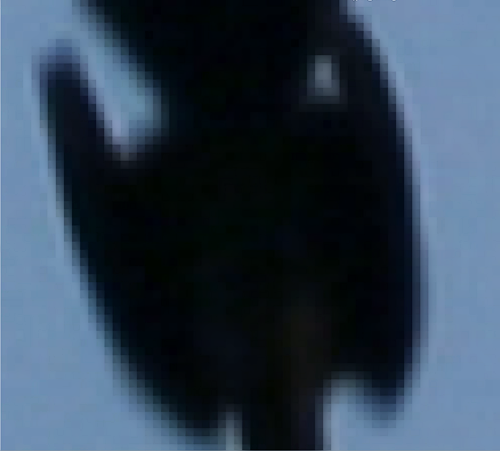July 30, 2003
Crabwalker
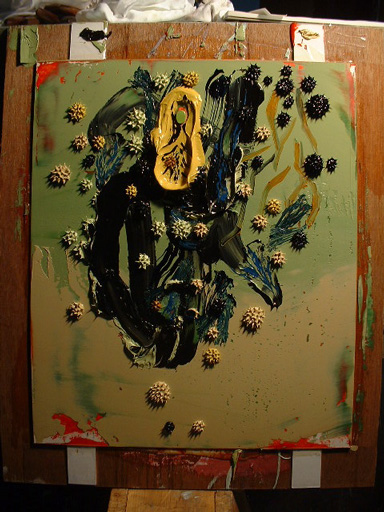
WOP 19 03
No title yet. I like the title to insist itself on me. It's kinda like knocking on a wall, looking for a stud. Kinda, sorta.
I'm ambling toward the next painting. Like a crab, the approach is sideways. It took some time. If I stomped forward after the last painting, I would have scared the fish away.

I'm definitely rendering here. I'm looking at the processed image cropped from Manet's "RAGPICKER" of course. In this one, I'm letting the skein of paint marks hang loose... not brought to several breaking points as I've done so many times before.
Each pass at the surface brings a tangle of marks that has a music to it, if I'm on my game. Then, with subsequent moves, noise enters the system... the mark too many. The next moves are editing moves. I might use a skipping trowel over the surface, flattening,knocking the cacophony down. Or maybe it's a cutting action, scooping paint out, spoonlike. Or as in these recent works (all from this year), the controlled impacts that begin to resemble sexual organs. Flowers! Let's call them flowers. These flowers bulldose the "noise" and orders the confusion. It's a cycle that revolves 'round to a different beginning.
This work on paper brings this helix of order and disorder to a close earlier than the work of the past.
This makes perfect sense to me, I hope it does to you as well. I'm sure to try to describe it again sometime.
July 29, 2003
The Environment 'Round Me
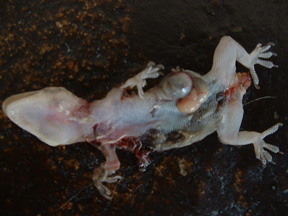
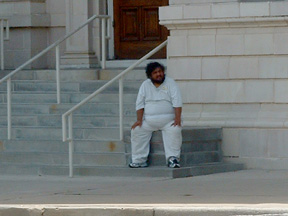
My cats love the Gekkos. The church loves the hobos across the street.
(No equivalence, just simply juxtaposed)
...and now, the 'scapes:

window.

a work on paper.

the planks.

the "baby asses" (visitors love to pat 'em).
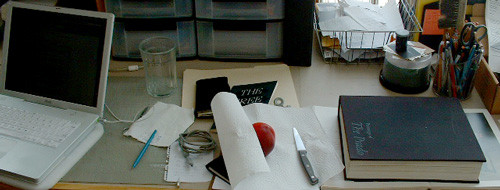
the laptop atop the office table.
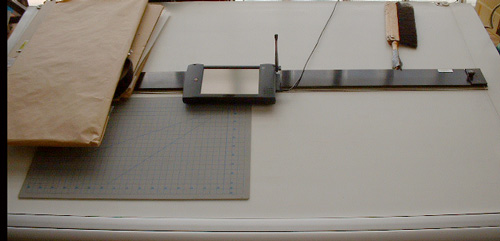
the Newton atop the drawing table.
Sonny Painted Saturn?
Last weeks' NYTimes magazine had an article about the possiblity that Francisco Goya was not the one who painted the Black Paintings, among which is the "Saturn, Devouring a Son".
http://www.nytimes.com/2003/07/27/magazine/27GOYA.html
"'I started to read what has been written about the Black Paintings,'' Junquera recalls in his small living room, crammed with books, bibelots and antique furniture, in the affluent Salamanca district of Madrid. ''I found that it was something impossible.''
He is suggesting that it might have been his son who painted these works, because the second story of the house he painted them in (murals, I guess) did not exist until after Francisco Goya died. The only way to tell is to conduct an architecturally forensic research which differentiates the former attic from the later addition.
Of the Black Paintings, "Saturn..." is the one that galvanized me to become a painter, an artist. I may have told this story elsewhere in this blog, but here goes (a mercifully short version):
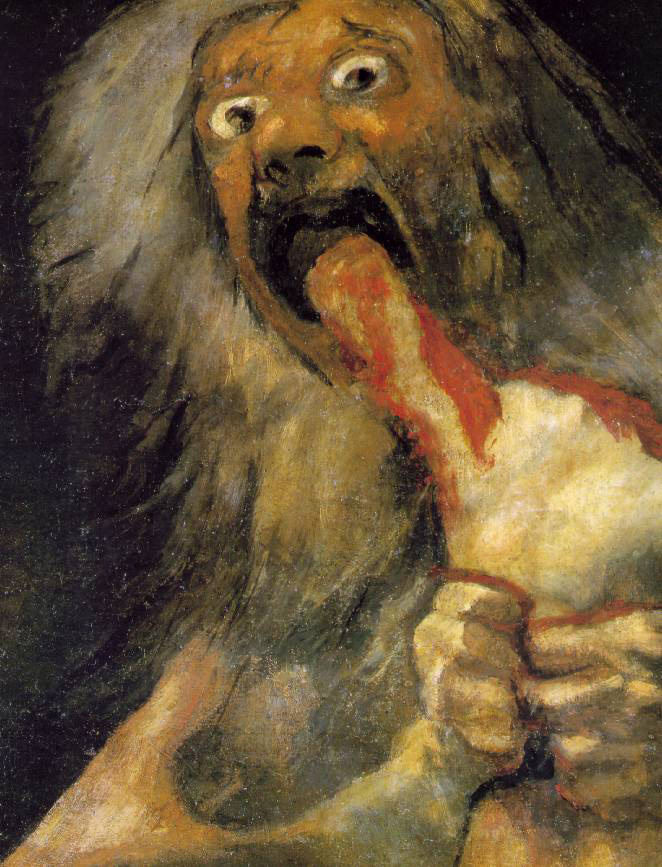
I have drawn since I can first remember. I recall how intoxicating the smell of Ticonderoga pencils were for me as a tyke... grandma would have a box in the bottom drawer of her bureau and I thought it was a treasure. When you're a kid, your senses are on overdrive, and the smell of Pink Pearl and freshly sharpened wood dominated me. I remember winning a drawing contest in kindergarten and sitting on the clown's lap on T.V., and I remember thinking it was a hullaballoo before that word entered my vocabulary. I remember mom bringing me to the YMCA's drawing classes and I learned about roughing in forms in stages and proportions... and a new piece of equipment entered the arena: kneaded erasers. A revolution. That was when I was in the second grade or so.
But it wasn't until I was fourteen that I found myself standing in front of "Saturno devorando a un hijo" that I felt the call. My family was traveling to Australia and we were taking the long way 'round. We went through Europe, the Middle East (only a refueling stop in Rhiyad, and for that we had to have our priest certify in writing that we were not Jewish), New Dehli (overnight, bats filled the air), Bangkok (for a weekend), Manila (for a month with family), then Sydney to stay... or so we planned at the time.
We stayed in Madrid for a week and my folks let me soak up the Prado. They dropped me off and I had the place to myself. I remember Goya's "The Executions of May 3, 1808", I remember D?rer's "Adam and Eve", Bruegel, Titian, and of course Velasquez' "Las meninas". Later on that week, I took a bus to Toledo and saw Greco's "Burial..." and his studio. By that time, I had read Stone's "The Agony and the Ecstacy" and I had copied the masters in the margins of the history books... I was ready for this. Being on my own for that week was a signal of adulthood to come, and to be alone with the Prado came a feeling of being at home, a fit.
And standing in front of the "Saturno" submerged me in a sensation familiar to me from my childhood. As a kid, really young, I would lay on the bed and look at the ceiling, staring at the patterns, the features. I would get all lost in the visuality of it, noting every little thing about it... and then with an amazing suddeness, the scene would zoom into a close up like a delerious photographer's zoom lens... as if my eyes were inches away. I would hover in this state for a while and pop out, if I lost a balance of sorts. This was the same sensation I had in front of Goya's painting, the pigments flooding my mind, eyes full and hovering inches form the surface.
July 26, 2003
Rocket ship
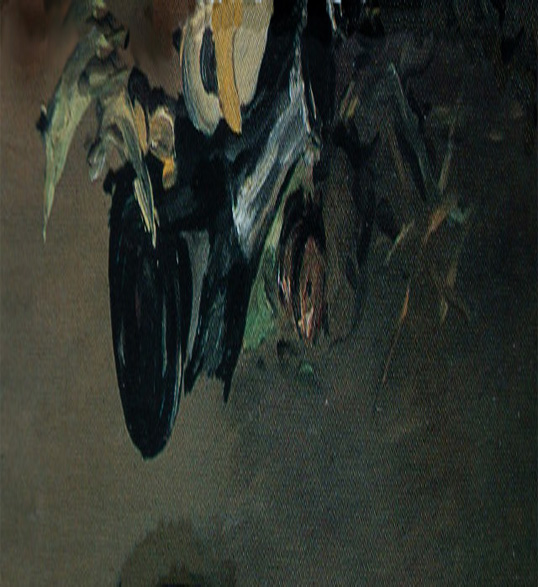
I'm still looking at the RagPicker. This time, with the proportions changed to the 48x44 of the panels I've prepared. So far, so good.
Concepts.
I think perhaps I should write a little something about ideas, artwork and getting started.
I substituted the architecture undergraduate experience for the art undergraduate one. So I guess it should be of no surprise that I think of words like "concept" and "conceptual" the way architects do. In art school, concepts meant ideas, in general. In architecture, a concept is a tool to achieve an objective. Utilitarian, in other words.
When I taught architecture studio, I would try to get the students to enlarge how they thought about concepts. I would begin with this definition of a concept as an idea which is used as a tool to achieve an objective. But what is an idea?
Then we would empty out the categories of mental contents from primitive to complex: notions, ideas, concepts, theories... (ok, you can throw in emotional feelings, sensations, ideologies, dreams, whims, urges... but I was leading them somewhere!).
Notions are the thoughts that sweep over you as you sweep over the world. They are thoughts uncomplicated, simple, unstructured. For example a thought of what good is as something favorable, positive or nurturing; and conversely a notion of bad is that which is undesireable, counterproductive, hurtful.
An idea is a structured complication of one or more notions in combination. For example, the idea: "evil is the good that's gone wrong" (please note, I am skeptical of this idea today... and it wasn't well thought out when I used it then.... it was a tool, too). Then I would show them how you could use this idea as a tool in thier designs to channel thier actions, the conceptual. By correlating notions and ideas to features in thier designs, the conceptualization would orchestrate their relationships. The design would have an orientation, a "point of view".
But once they had a handle on this, I wanted to make sure they wouldn't over rely on it either. So I would trott out a simile: An architectural design is like a rocket ship: When it blasts off the pad, the engines are the conceptual, lifting the design process off the ground. As it progresses into space, each engine stage is cast off until they get progressively smaller. Finally, all is left of the conceptual are the tiny retro rockets that keep the payload on track. And what is the payload? The lived architectural experience, of course.
The concept is a tool. It's value serves a larger purpose. In architectural design as in the tools I'm using to get this painting off the ground. Manet is my rocket ship. The payload here is the lived experience of painting.
July 25, 2003
Counter-Strike
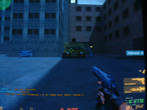
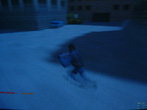
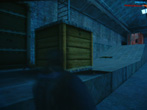
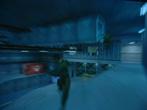
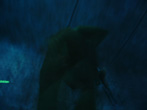
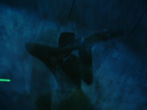
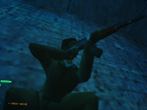
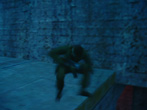
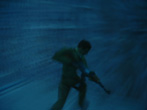

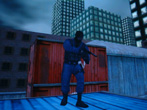
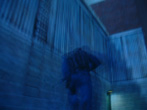
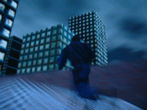
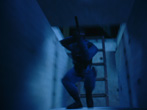
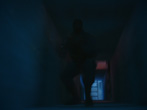
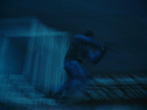
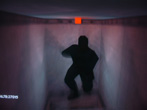
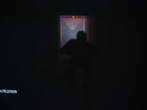
What's cool about Counter-Strike (aside from the KICK ASS avatar-you are there first person shooter action) is that the game was created by people who just love the game and not some big money corporate gambit. They were amateurs in that they did it for love, simply amour... amare, to love. It's a modification of another game called "Quake", an existing computer game taken off the shelf, the makers of which were open to the changes made. For a few years after 2000, the game prolliferated on the net, all grassroots enthusiasm.
Low ego.
Playing this game here in Dallas isn't as easy as I had it in LA's ChinaTown, where "CyberLan" was just around the corner from my studio. What was cool about the place in LA is that it was created by two "kids" (young men, really) for thier friends. Real down home, with class. The place was put together really tight and real to the economic milieu of thier community.
The gaming place here is decked out alright, but the owners are all business baby tycoon types, with a surly MBA wannabe attitude. They have L.L.C. appended to thier name and they talk about bankruptcies over the phone.
High ego.
Prior to this, I had only played CS once since leaving LA February. I've got a little jones, but it's not too bad.
In Counter-Strike, a team of counter terrorists go after a team of terrorists. There are several "maps", or virtual environments: Las Vegas, an oil refinery, etc. Sometimes, there are hostages to rescue, sometimes not.
After 2000, this game took on an enhanced edge. My father was a casaulty of the Korean Conflict, 50 years after the fact. After my my father passed away, I would imagine how he might possibly have been cured by playing this game. Silly of me, I guess. Playing this game is a way to get closer to my dad, living a ridiculously miniscule fragment of what he went through... if that.
After 911, playing this game became a way to cheer the troops on. Through the avatars, you surge through the gameplay, adrenalin pumping, flush. And somewhere else in the world, someone was surging in real "play", adrenalin pumping, flush.
This week, three bad guys died, monsters all. The world is better now that they are gone.
July 24, 2003
Rags Picked
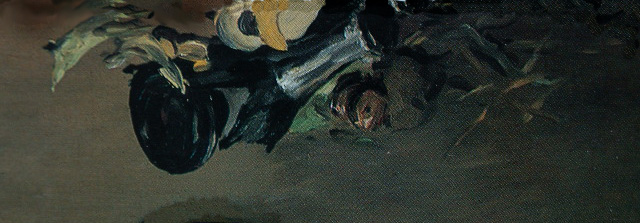
Ok, so I'm looking at Manet's Ragpicker, the namesake for the last painting. Crop and flip, Georg Baselitz style (strange-ify it). Study. Take notes.
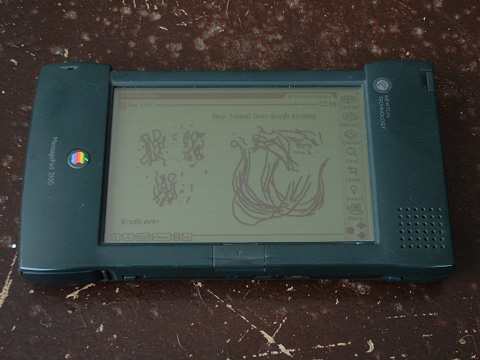
Geek Alert. I confess: I love the Newton MessagePad 2100. And Damn Apple for spiking it from the line.
I tried to photograph the screen, but this camera can't capture the beauty that is the Newton. I was taking notes for the next works on paper. I like the stylus/touchscreen. The drawing function es muy sympatico. And the handwriting recognition is excellent. Tons of functions, all interlinked. instant on. Internet, Fax, yadda yadda.
It was years ahead of it's time.
Ming Dynasty
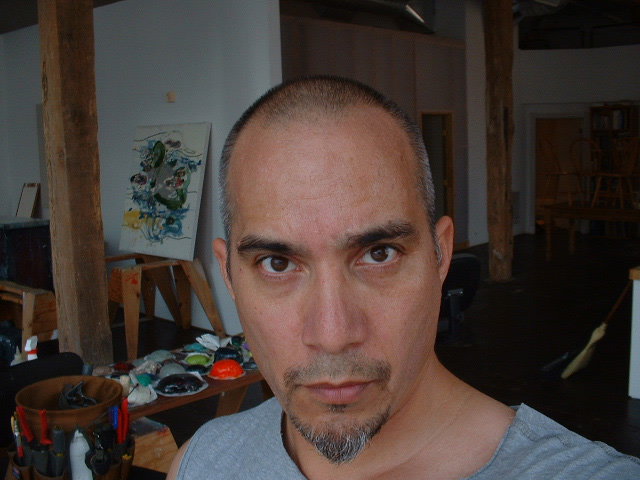
I tried to shoot the beads of sweat on my brow. Better luck next time.
July 23, 2003
Ragpicker
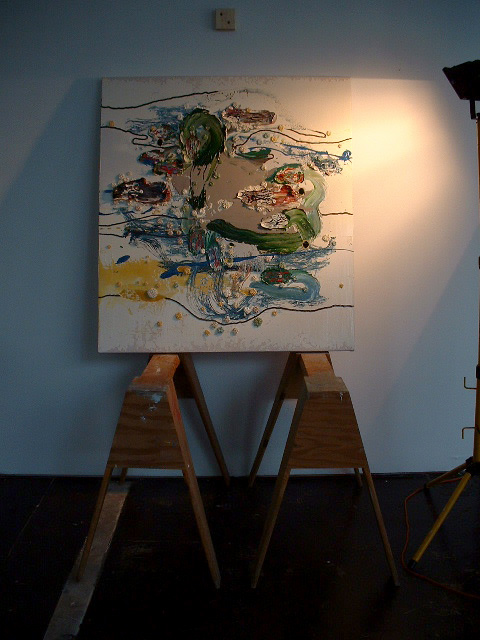
I spent the day tweaking. Little details.
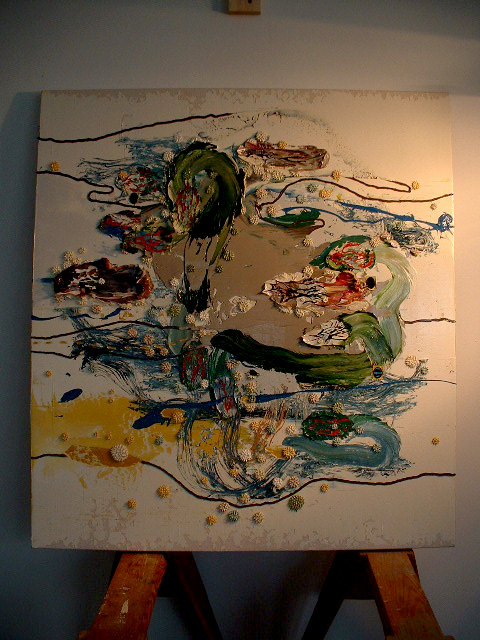
Nips and tucks.

A pleasant day.
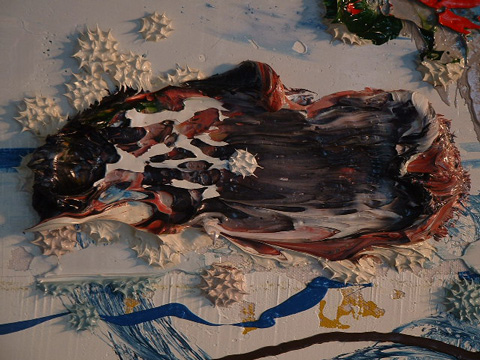
I look over detail for detail, looking for fullness or lack. I pour over the surface, eyes agog. Sometimes, I have to pull back and squint to check the overall composition. But the major compostional effort is spent by now. At this stage, I can only try to bring certain parts to a peak power
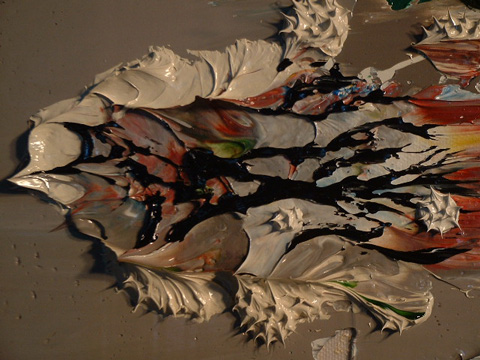
Sometimes by the addition of the little spiny balls I call "monads", I can take a certain place and magnify the uniqueness of the features of that place. I have a theory... the spines of the monads provide an abundance of visual detail. And this excites the eye to see more detail within a corona surrounding the monad. A halo of excited visuality. The painting becomes a teeming site of these halos, a hive of altered states.

Sometimes, most times, I can scoop out an offending piece of the surface. I keep large shears and carve stiff cardstock into the proper tool. Utilitarian origami. At the beginning, I'm aware that the first layer of paint might be seen again.
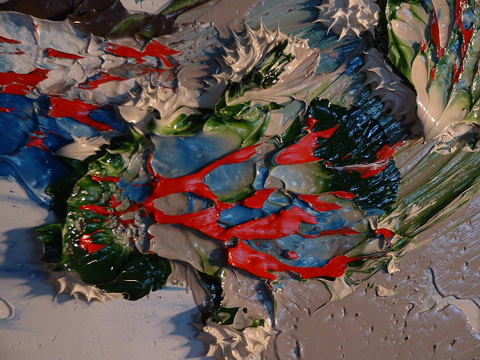
Dinner Table

I read Paul Berman's "A Tale of Two Utopias" in preparation for his recent book "Terror and Liberalism". I'm glad I read the former. It filled in a lot of gaps in my knowledge of the history of humanities in the West. Before, names like Glucksman, Dewey, Whitman, Foucault, Hegel and many others were disembodied for me. Olympian. The intellectual and creative universes woven for me in school reminded me of Hesse's glass bead game: mandarin, obscure, untouchable. Berman renders them in a living and breathing context, human beings with genius and shortcomings aplenty. Just like the rest of us.
July 22, 2003
Like a Ship Coming into Port
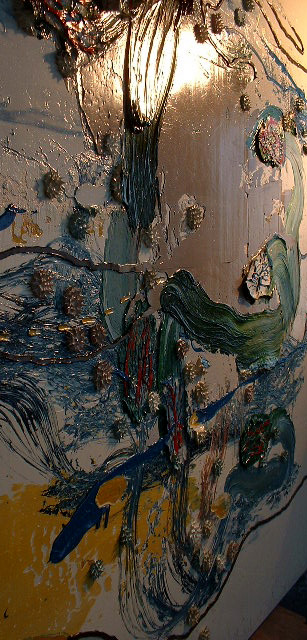
43 hours into this painting. Up against the wall and the wall is dry paint. Or, drying paint. Once the surface begins to consolidate , a displacement of the mass will make the body of paint mealy... not the buttery goodness of the beginning.
I wish I could paint the whole time... the body relents, fatigue sets in. Catnaps, love 'em. Back in ChinaTown, I would sleep on a blue mat at the edge of the stage, eat take out, the place was Spartan. Now, this loft is luxurious in comparison. A big refrigerator, not the forty dollar college dorm special. A full kitchen. A sleigh couch, a bedroom, a shower. Satellite big screen TV, DSfreakinL, ohhh yeaaa... No cockaroaches, no fleas (like the CT back alley infestation problems of old)... relatively speaking. A palace. A kingdom of sirens... and like Odysseus, they must be resisted or else.
Ok. A little dramatic. A little more sugar in an already sweet life. Thank you, Lord.
43 hours and I'm three quarters of the way thru.
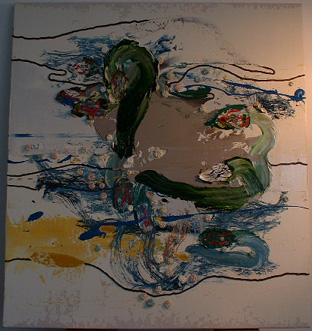
I think I'll call this one "Ragpicker" in homage to Manet and the Norton Simon, the thought at the beginning of it all.
I've been thinking of the next painting that could take this inspiration more literally, as a starting point. In my mind's eye, there's the murky monochrome of the background and the scumble that becomes the figure of the rags in the foreground. Next: a work on paper to flesh it out.
Flesh, carnitas.
July 21, 2003
BLAST SHIELDS! UP!

Time to fling the long horizontal strokes.
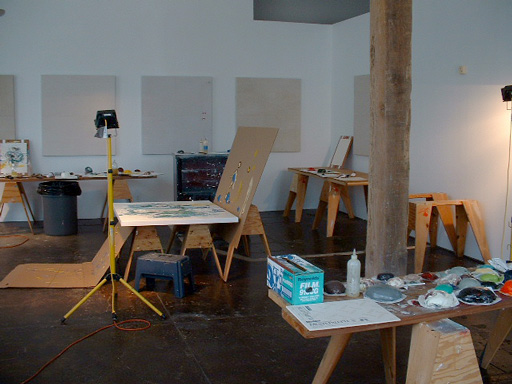
I'm not into the cluttered studio stylings of artists of old. I'm thinking of Frances Bacon's studio. A rat's nest. Like I used to say to my students (architecture studio): " Your studio is a picture of the contents of your mind". I just wanted to freak them out a bit, make them a little self aware of their surroundings.
Maybe Bacon's mind was like that... but you couldn't tell from his paintings. His work was tight. Tight. I remember seeing a show of his work at LACMA. That was a special moment for me... a special clarity. I could count a discrete number of "moves" that constituted each painting. The architectonic interior lines. The spray. The stamp of a bottle cap. The clot of paint. The blend. The fling. Every one isolated, and yeat all held together in a controlled avalanche towards abstraction.
Sometimes. maybe too many times, I think of the dangerous boundary of LeRoy Nieman's work as a cautionary limit indicating the problems of a facile approach to representation. I should throw that away and hold on to Bacon harder.
Studios. I remember the Pollock show at MOMA. They recreated his studio in the museum. It was tiny but it felt big. I remember pictures of Jackson working there, not tidy, but he had it together... everything was useful and in the right place. Kinda like my dad's garage.
I work horizontally and vertically. Back and forth. Lights on and off. You can see the saw horses to the right against the wall. When the paintings get over eight feet, it's grunt time, a little desperate behind the panel. That's the physical limit without assistants.
I don't know how I could ever have an assistant.
July 20, 2003
A Direction
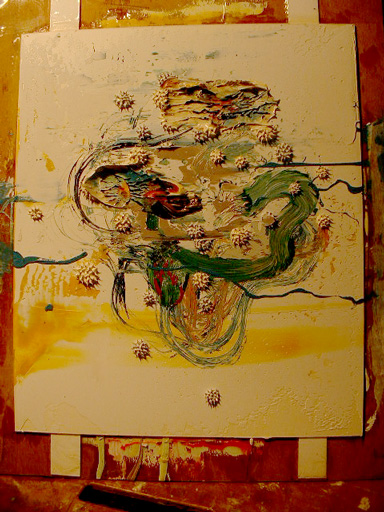
Here's the work form the night. I like the wee hours, and it's better when I can play music loudly every so often when my energy sags.
I think this is the way to go for the first large painting (48"x44"). This is a work on paper, very thick board that is. I'm looking at the light touch, a magnum of paint applied with a magnum of control. The last work on paper tried the former dominating the latter... and I see a limited opportunity in that direction. For now.
Shifting toward the lighter tonality gives me some room to move, shifting from erasing to marking, modulating until I get the painting I want. I'm back to a central organization again. The previous work on paper is also different in that it is a field more than it is a figure. As always in this relation, one emerges from the other: the field puckers towards figure, the figure submerged within a field. Or alternately: if I expand the figure towards the edge, I might be able to get to that place. I think of these ordinates of figuration as the energy that empowers this abstract project.
This was shot in the morning with my halogen work lights, so they are shifted to yellow. I've corrected for light levels with photoshop. I like the high raking light. Someday, I might be able to reproduce these conditions in a show.
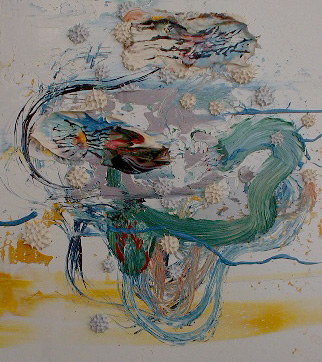
Here's the same piece shot in interior daylight. I've cropped it in anticipation for the next painting.
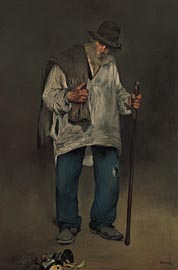
I was thinking of Manet's "The Ragpicker" (from the Norton Simon's collection in Pasadena). It can seem as if the field that surrounds the old man became the favored expression of a modernity that dematerialized painting first in Duschamp's urinal, thenKlein's monochromes, then through the stages of the PostModern permutations (Pop), minimalism, conceptualism and the broad meandering brackish delta that once was a crackling mountain stream. what is amazing about Manet is his touch, how he continued the legacy of Spanish painting. The flesh of the corporeal paint was parallel and as fully realised as the virtual flesh of the figure depicted. Shimmering both up at once is the feat of it all.
There seems to be that as one sees the figure virtually, one is also extremely aware that a figure is rendered. On one hand is the invitation to illusion, and the other, a simultaneously vivid recognition of the mechanics of it's manifestation. The puppet's strings are digitally eliminated.
This is different from today's world, where there is no value attached in balancing opposites. In our time, there is an ambient invitation to lose oneself in the fantasy of it all. It's an extremity, almost a fanaticism where ideology is all important. Partisans and true believers. A world of Tweedledee and Tweedledum.
July 19, 2003
The trouble with Cad Red
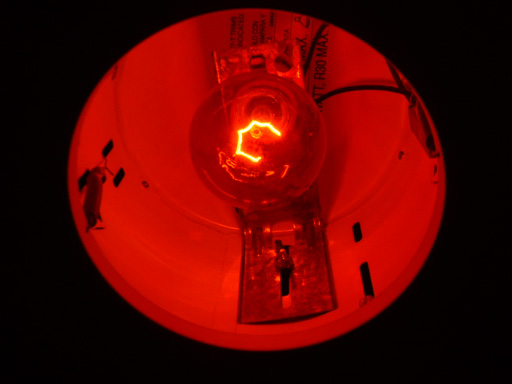
Cadmium red is beautiful, but the wavelength is short and the tonality is dark. It needs light to ignite it. I should relax with this limitation, that making it work in low light is difficult. So why try? I'm a little hard headed sometimes.
But I do like it flooded with light, a high raking light.
I like red lights. Once in LA, I was stargazing one night in the backyard, and I replace most lights inthe house with red bulbs. It freaked Stephanie out when she got home.
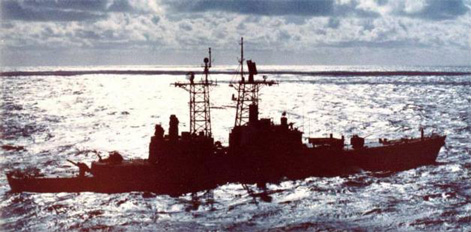
Red lights take me back to the years in the Navy. I worked in the Combat Information Center, the dark room behind the bridge that contained all the electronic sensors.
http://usmilitary.about.com/library/milinfo/navyjobs/navyjobs2/blos.htm
Lights around us tended to be red to keep our eyes adjusted. At night, the ship would be, light tight, traveling incognito. You would have to go through light lockers before you got topside, flat black vestibules with baffles so light within wouldn't escape. The world in low light is amazing. You see with rods, not the cones. It's like peripheral vision, there must be a cognitive difference to it.
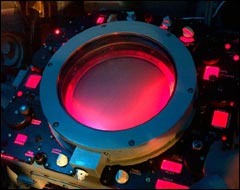
Radar guys, scope dope. It was the brain of the ship. A philosophical model of man, moving blind into the night... reconstructing the world plot for plot. Where are we? Who's around me? Who is friend, who is foe?
http://www.geocities.com/Pentagon/8035/
July 18, 2003
Cadmium Red Deep
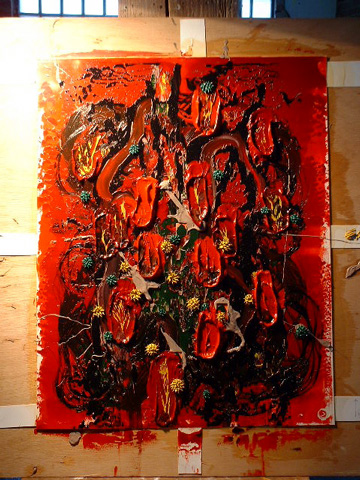
Usually it works this way:
I saw in an earlier painting (see the July 14th post) a interesting direction, an inkling. As I flesh it out, I find the extents of the imagined destination and I discover things along the way. Which is to say, I am disabused of certain preconceptions owing to an overripe imagination... and as I mash into the material facts, I learn something new. Something indifferent to my original agenda, if I'm lucky.
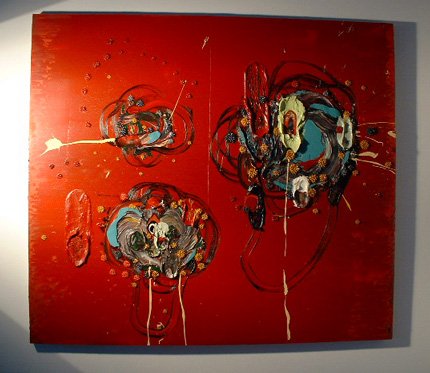
In this case, I was looking at the third painting I did since arriving in Dallas. I like the Cadmium Red Deep, deepened by a little Alizarin Crimson. In this painting, I was tracking a (familiar) strategy of figuring the work into a ball floating in the upper center of the canvas. The problem is dynamically merging various ways of markmaking in suspension so that each mark has an integrity whilst being deformed by the others.
Integrity and Deformation. Yea, thats' it.
There's a moment of failure where the additional mark deflates a certain charm of the work... and I look to a ramping up of the action towards-but-not-touching chaos... a maximal fugue that still has a fullness of beauty to it.
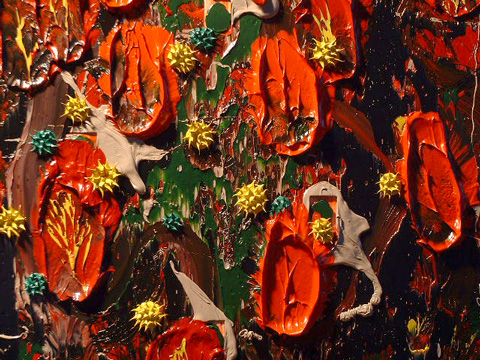
And now, I'm thinking something not so deep in saturation. The linen panels are very blond. They are not the usual deep brown of the Belgian Linen that I have used in the past. And I like the difference, and the colors in my mind are lighter, whites and yellows.
Inklings.
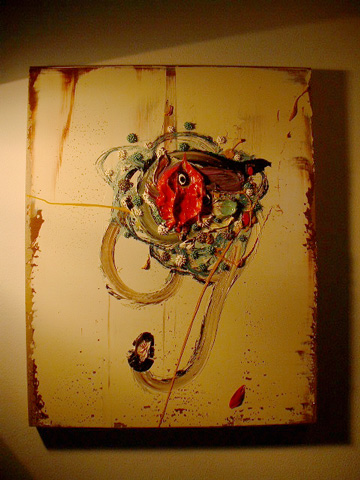
This is the first painting done on panel since coming to Dallas. It follows a few works on paper, two of which went to Mark M?eller Gallery, who took them to the Basel Art Fair this summer. The central mark in red was something new, done first in the long horizontal paintings I painted before leaving Los Angeles. I've got a good feeling about them. I want to do more.
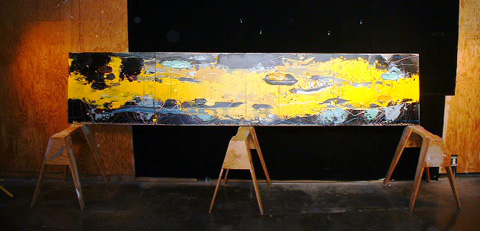
"Overland II"
July 17, 2003
Scrape off
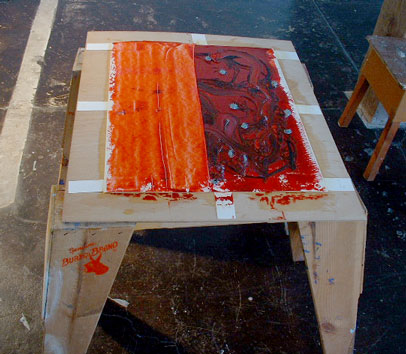
Pacing. Looking. Circling. A false start. Scrape off. I'm looking for a hand hold. Some thoughts are good to get started, but not good for the going. Some thoughts just get you into trouble, but at least they get you into the thick of it all.
Agitated. Can't sleep well... don't want to. Go to bed with my boots on, full of hope. Pacing. Staring. The pregnant pause. Fret.
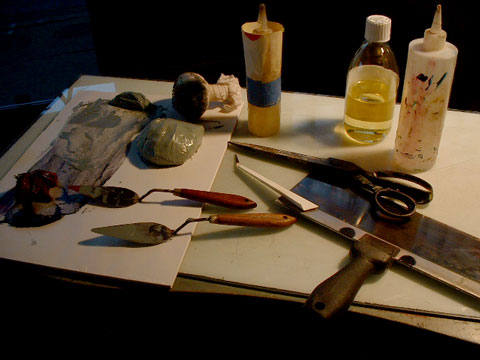
Dallas, Texas
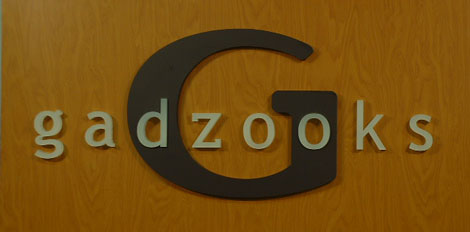
My lovely and wonderful wife Stephanie was offered a job at a company based in Dallas, Texas... a company that is undergoing a redefinition of itself in the fashion marketplace.

It was a crossing of the table for her, to go from the manufacturing world to the retail world. A blossoming. A new horizon. How can a loving husband say no?
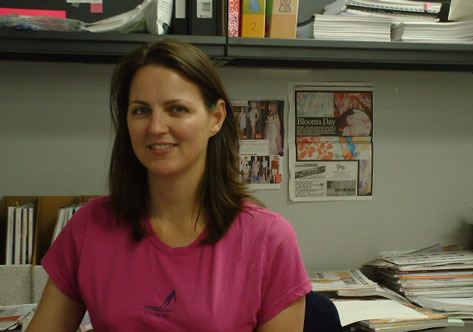
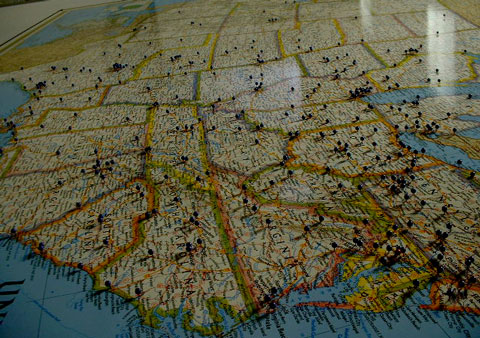
Gadzooks came to life in the era of "Fall into the GAP", the earthy fashion era of the late seventies and early eighties. They used to sport a volkwagon beetle and a checkered tile motif in all their 400 stores across the country.
Now, the abbreviation "G" is the silent successor to the name, and this summer, they are undertaking the feat of liquidating half of their market, the boys section of a teenager address, and refocusing on young women's (read: "sexy") exclusively from now on. A flip from the trapeze on high, no nets in yanqui land.
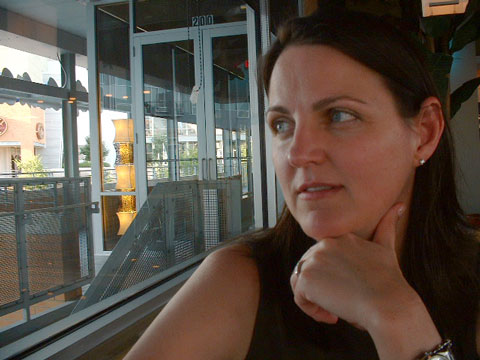
Paul Berman
I'm almost done with "A Tale of Two Utopias", a history of the children of '68. It's strange to read about a period of time I lived through, seeing parts of the rest of the world writhing as it did. In 1968, my family was in Las Vegas. My dad had just retired from the Air Force. Wanderlust struck and we moved to Florida. Wanderlust struck again and we moved to Australia in '71.
All these years, I've read and searched independently for my bearings, flinging myself out very far, very wide. Only after all that, can I read such a history without being utterly lost without the familiarity of the context to grasp this tale of cultural/political history.
And I realize just how off page I am from mainstream intellectuals, those who contributed to this history. All my coordinates are different, my wiring arranged differently.
Berman describes Vaclav Havel's history, Page 224:
"...Not Havel. He grew up in a wealthy bourgeois home in Prague that gave him what he calls 'a heightened sensitivity and aversion to various manifestations of social inequality.' He considered himself a socialist, only he was one of the few who insisted on drawing the proper line between socialism and Communism. Socialism was for him, as he has written in his Summer Meditiations, was a 'temperment, a noncomformist state of the spirit, an anti-establishment orientation, an aversion to philistines, and an interest in the wretched and humiliated."
Ok. But I think of the polititcal direction of the left as a communitarian impulse, a paradigm of family. Aversion to philistines... claro que si. I'm not sure what his interest is in the wretched and humiliated... this could be perverse as well as altruistic. Noncomformist? It's hard for me to buy the idea of his non-conformism that is derived from socialism... isn't this... social, isn't socialism conformist even in the most innocent and elementary sense of the term?
There's little time to flesh these thoughts out right now... but here's a fragment of a letter to a young artist that seems relevant here:
**********************
"Feeling like an outsider now is a theme in my life."
As a friend once used to say: "That's called 'welcome to the club' ". I grew up with that feeling. There's some comfort in meeting a fellow traveller, a flash of recognition in an alienated world. A tip of the hat in an Eastwood film, and the undercurrent that what makes us feeling different from everyone else will keep us feeling alone, even as shared with compadres. I waver between the idea of ultimate isolation and the recognition that we are all, as Westerners, feeling the same feeling. We are all Odysseus, longing for home. (Have you read the llliad and Odyssey yet?, Homer's primal story is important for people like you and I.) Here's one story about how this was driven home for me:
One day during a Winter vacation in undergraduate school, I decided to visit my mother's side of the family. They live in Sydney, Australia... after immigrating from the Philippines in the early seventies. I wanted to plug into the family, to reinforce the feeling of home and belonging. The arrival was dramatic. My grandfather was a classic patriarch. I met him in the mid evening in his bedroom. He was in bed, the night stand lamp was the only light on, rendering a dramatic scene. I went up to him and took his hand in traditional form, pressing the back of his hand to my forehead, kneeling. He asked: "Why are you here?" I responded, "To be with the family, Papang". He then said the words I'll never forget:
"I forgive you for being half American."
Jeeeeezuuuus! That just demolished me. My grandfather had harbored an antipathy for who I was, who I am? For all these years, I thought I had been in the bosom of family... and I wasn't? I had reverb from the first time I had be struck so: When my folks divorced within few weeks of my high school graduation. Shortly before that, I remember thinking: "Now that I'm about to leave home... I can always feel the anchor of my family, no matter where I go, my folks will be there for me." How clueless I was. Am. Or to be charitable to myself, how unreasonably hopeful I am.
For the days of the vacation that followed that announcement, my grandfather, who had hauled himself up from poverty in Manila to become a lawyer, a teacher and a small time politician, dressed out my strange pardon. Typically, after dinner, Papang would hold forth. He lectured about the real history of the Philippines: how the battle of Manila Bay was a farce, how Americans replaced Filipino culture with Yankee culture, how they resented that they knew more about American history and spoke better English than Americans themselves. At another party, he held forth about a comparison and contrast of the West versus the East. The former was about the individual, the latter was about the family. Societies based on the family unit don't need governments per se, look at China. They have enjoyed six thousand years with one government after another... the patron of each family takes care of things. If one family member has trouble, the others buck him up. But for the West, you're on your own. My uncles were called forth to testify: "We immigrated to Australia over the States because here, it's 'Put a Shrimp on the Barbie, have a nice day, Mate.'... the social system is protective here. In the States, the opportunity to succeed is also the opportunity to fail... you live with a lot of anxiety there. " For my grandfather, the appearance of my Yankee father was a threat of individualism.... solvent to the glue of family.
As the days of that vacation passed, I also saw the darker side of family. My grandfather was imperious. He would lose his temper at any slight... and would invent one if none were handy. He would demolish an uncle for no reason, in full view of the others in the family... perhaps for them all in particular. As he was polishing off his lecture series, I began to realize that I was a Yankee, deep down in my core. I valued my individual freedom too much to construct my portion of family... in those terms, at least... especially when I saw that by its' very nature, any and every effort would never be enough. The tribal chief's job of familial construction would never be done... and worse, the imperative of family bonding was so great that it was justified to demolish individualism where ever you find it, with an urgency that scared me. I didn't get what I came for... or maybe I did and I realized that I didn't want it the way I found it. I was in the early stages of my elaborate art education then, the third year of architecture school. And this revelation helped me see the world more clearly. At least, it helped me order it in a way that made sense, and in a way that would extend from politics, to city planning and ultimately, theory in our art world.
Tech problems
I'm having a little trouble getting images up onto this blog.
Patience.
That's what I need. Maybe there's some trouble at Moeable Type or the web server?
Patience.
I feel the undertow towards geekdom.
Troubleshooter.
Patience.
July 14, 2003
Road Map
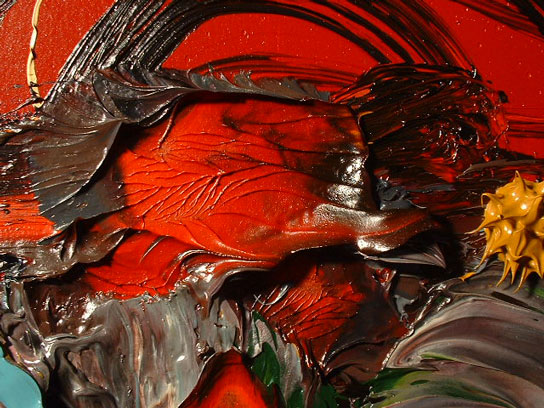
Here is a detail from the last painting that has stuck with me. I'll be working in this direction, at least to get into the next round of paintings.
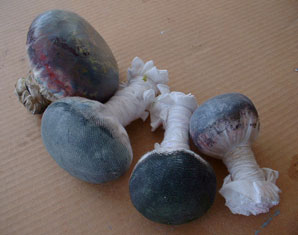
I use these handmade tools for the job. I fashion them out of rags for the task at hand. A mega daub, a rocking motion, a little suction and what I get is a displacement, bulldozer style... with a nice little fractal in the middle... if I'm lucky.
July 11, 2003
Currently Reading
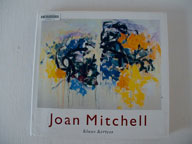
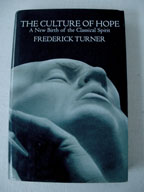
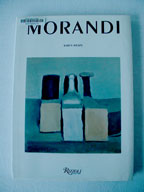
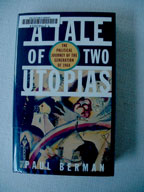
The Dallas Public Main Library is just two blocks down the street. It's a big building of maybe eight or nine floors (I could stick my head out the door and count floors... nah.). The neat thing is that when I hear of a good book, I can search their database onlline and order it up via their website. They send me an email it's there, and wala!
The Joan Mitchell show is coming to the Ft.Worth Modern Museum, so this is required reading...I contacted Frederick Turner after reading an article of his online and emailed him after I discovered that he teaches at U.T. Dallas... Morandi... well, I like his paintings of course.... I like his dogged scale, how he can open up his world on his terms...and I heard Paul Berman speak about his book "Terror and Liberalism" on cspan I think... and I began reading this one written in the late nineties about the intellectual generation of '68 and their legacy. A really good read... except for the unavoidable acronyms that slow me down.
a Group Show at Manny Silverman Gallery
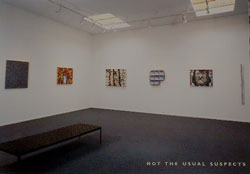
Jimmy Hayward has been moving a traveling road show around the SouthWest this year, this time at Manny Silverman's place in West Hollywood. They called it "Not The Usual Suspects".
left to right:
James Hayward
Michael Reafsnyder
Sam Tchakalian
Wess Dahlberg
me
Richard Allen Morris
Full generational spectrum. Not the usuals, probably because not many other painters out there are getting sticky fingers in the material like we do. A good place to be: unusual. Even in a time of the ferocious herd.
previous incarnations:
"Phat and Sassy" Charlotte Jackson, Santa Fe
"Five Times Four" Modernism Gallery, San Fransisco
I missed the opening, sorry guys. Time and money, yada yada.
(photo credit: paula goldman)
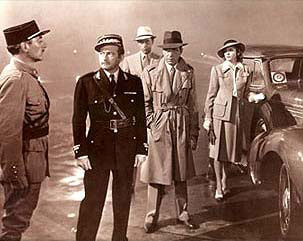
I keep replaying scenes of Casablanca in my head.
So I jump on my trusty horse, Google. Here's the next beat in the movie:
"Knowing that there are no witnesses, Renault overlooks Rick's crime and the police carry away Strasser's body. Rick looks back at his French friend with a half-smile. 'La Marseillaise' begins to play slowly on the soundtrack. Next to a stand-up desk, Renault picks up a bottle of Vichy water and opens it:
Renault: Well, Rick, you're not only a sentimentalist, but you've become a patriot.
Rick: Maybe, but it seemed like a good time to start.
Renault: I think perhaps you're right."
http://www.filmsite.org/casa5.html
Wood Butcher
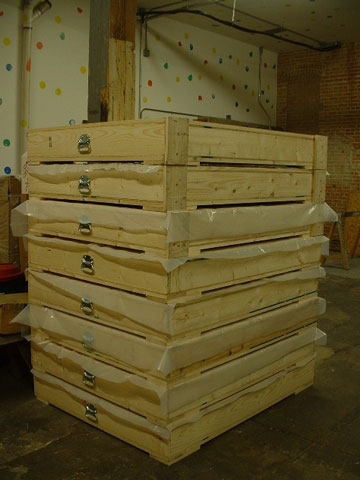
Finally finished building the crates. This is a first for me. The idea is to trade transparencies for crates with CM. After moving to Dallas, I didn't want to find a photograoher anew. I'd rather transisiton to digital cameras sometime in the near future, once the technology can deliver around ten megapixels for less than a thousand dollars. That should be sooner than later, but in the meantime, I'll still need transparencies. By building out the crates, I can provide a crate per painting, to protect it where ever it goes. a nice idea, but it was a brutal job: lots of wood, sawdust everywhere, seemingly endlesss process. But once I have the equipment out for panel building, why not go for it?
Building the panels are different. At least I can anticipate the painting to come. I make plans for the painting as I am asembling the panels. But the crates are monotonous.
Now, it's time to seal them with mat resin. I'm taking a departure from the Belgian linen that is commercially available in the art stores. My mother, who imports antique fabrics from Europe to the States, has given me a quantity of antique linen, about a hundred years old, hand made. They are blond, not the dark brown of the Belgian variety. I've wanted to shake this up, shift to canvas perhaps.... this is better, qualities of each. Plus, I like the human hand in them.

A long day into night. More fun tomorrow.

Fresh start for tomorrow. Sealing, three coats. Hook straps screwed tot he back. And work on paper in the meantime.
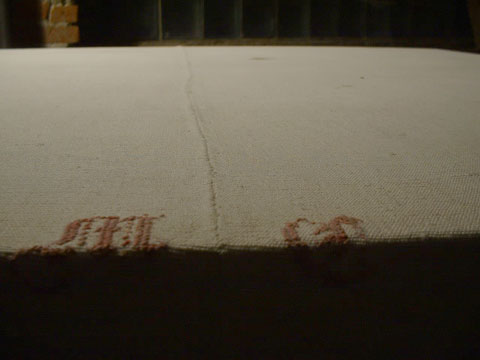
They have monograms. That reminds me of my first work out of grad school where I would paint "sandwich paintings": a bottom image was walkabout and an upper image was a letterform struck over to end the piece (which I imagined to be a Rusche operation in reverse)... so the reappearance of letters is an old friend for me. We'll see if we can see them later.
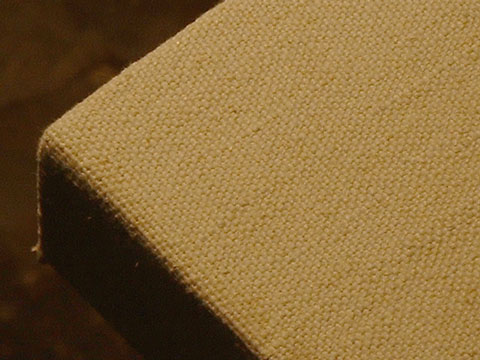
the linen covered panel corner in closeup
July 9, 2003
Obie
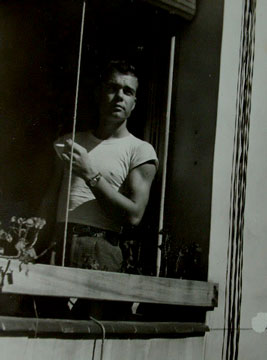
Happy Birthday, Papa.
Obie Hollingsworth, Jr.
Rest in Peace.
1932 - 2000
I remember a day when we were living in Panama so long ago. My brother and I were in grade school at Howard Air Force base, the Canal Zone. When I think of those days, it's a tropical memory, heavy humid air, beauitful sunny days, lush jungle vegetation, stunning beaches. Johnson grass grew tall and was ubiqutious. The edges of the grass blades were sharp enough to cut the skin if you weren't careful. In those days, we had animals at home: toucans, iguanas, parakeets.
Our school in my mind has that vivid sheen of a memory forged through a child's eyes. Scale is dramatic, color is searing, sensations sharper. I was in the third grade, my brother was in kindergarden. I remember reading Heinlein's "Have Spacesuit, Will Travel", and a book about Egypt, the annual flooding of the Nile.
One day, my father appeared in our school and pulled some special Dad authority to get his kids out of class. It must have been something important, I remember thinking. We processed out of the place, special papers and all. My brother and I clambered into the blue Impala station wagon. There was fishing tackle in the back, which was not that unusual, Papa liked the outdoors.
We drove for a bit. My Dad wasn't a chatty guy. He was in a good mood, but then he usually was anyway. I asked what was going on, but he was cryptic, smiling. We talked about what we were learning in school. Papa was comfortable in a car, a streak of wanderlust runs in the family.
We pulled into the jungle and ambled down primitve roads. Bush. And we stopped at a stream deep enough in places to be in over your head. Papa looked over to us and winked: "We're goin' fishin'!
All that day he spoke of his love for nature. The smell of the homemade bait. A little sunburn. Sandwiches and Cokes. I don't remember catching anything. It didn't matter anyway.
July 8, 2003
Alley Oop
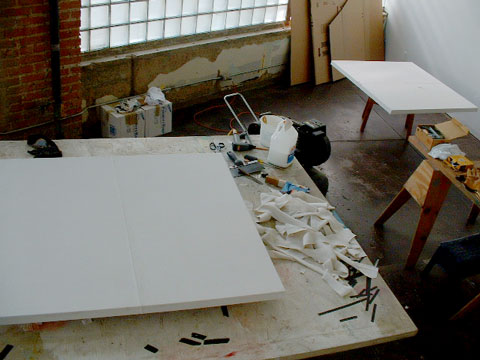
Eight times over. Bleached Linen. Two blisters, much satisfaction. Now, crate building (I want to crate each painting... for the first time.) and Mat resin sealing. Time to go... to buy wood.
July 7, 2003
Biblical
Our place is located on a street corner in downtown Dallas, so the street sounds are pretty significant. Street traffic of course. Passing homeless, some of which are quite vocal. "I"M THE MAYOR OF THIS TOWN!" Our a/c unit is located within the loft, and it is an industrial variety, so it's pretty loud. The volume of our radio and television is constantly modulated up and down to compete with the ambient nose. And now, a new addition to the chorus: cicadas.
Pronunciation: s&-'kA-d&, -'k?-; sI-'kA-
Function: noun
Etymology: New Latin, genus name, from Latin, cicada
Date: 14th century
: any of a family (Cicadidae) of homopterous insects which have a stout body, wide blunt head, and large transparent wings and the males of which produce a loud buzzing noise usually by stridulation
A very loud buzzing noise! Southern charms.
![]()
July 5, 2003
Last Weekend's Road Trip
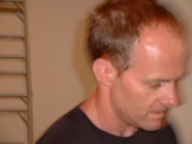
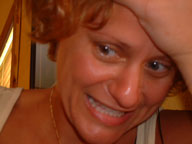
Here's some images from last weekend's road trip. A rendevous with Aaron Parazette and Sharon Englstein in Houston. Then an artwork haul to San Antonio with Aaron for his show there at FineSilver Gallery. Lots of chat time. The next day breakfast with Frances Colpitt, it was good to see her again. Parties. We took a tour through Chris Earck's collection, then a return to Houston. Parties. Then an opening in Galveston with work from Aaron, Sharon, John Pomara and Scott Barber among others in a group show. Click on the extended entry for images....

Aaron and Gabriella, the Director of FineSilver Gallery, setting up the show.

Galveston: Sharon's sculpture in the foreground, Aaron's digital images on the wall.
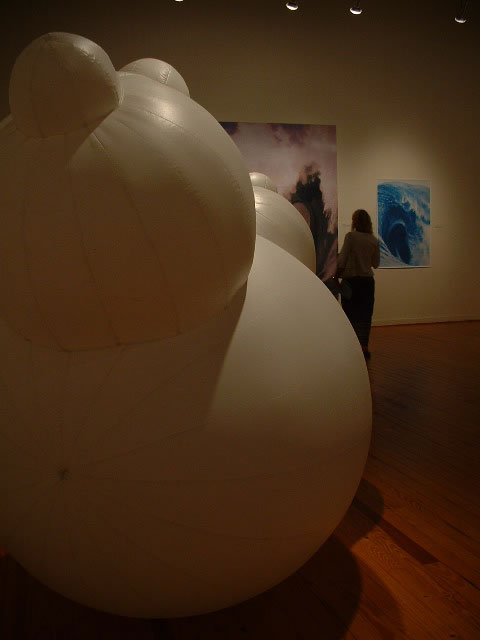
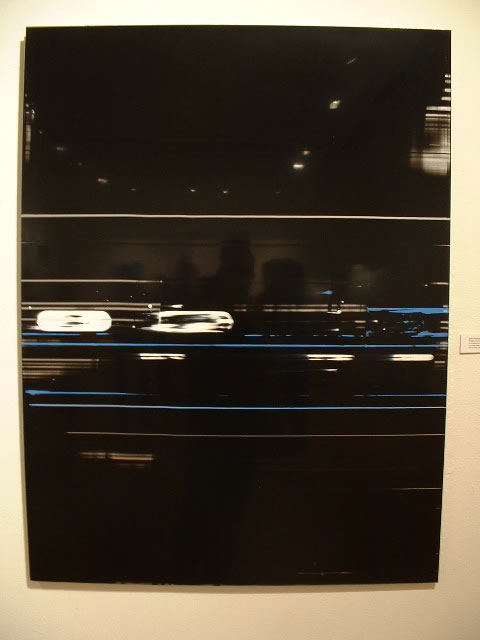
John Pomara painting, screeds and enamels on corregated aluminum. Pardon the distortion.
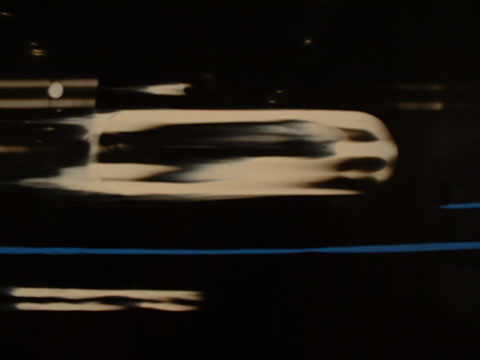
(Detail)
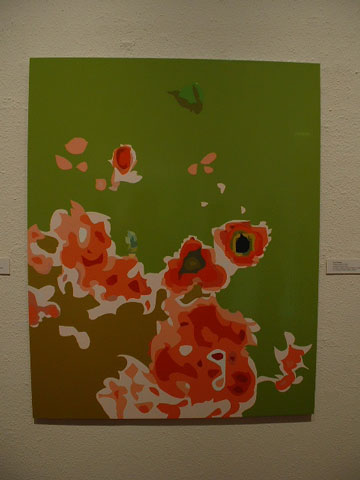
Scott Barber's working with enamel and aluminum too. He's masking and cutting alot. Images are indexing cellular/astonomical/floral motifs. The colors are punchier than this jpeg shows.

(Detail)
PRESTO!
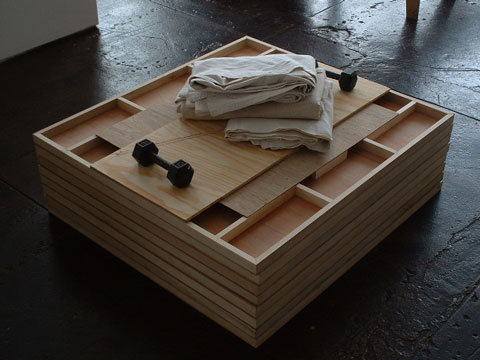
Eight panels, 48"x44"
Next: stretching them with linen. They look like canvas, but they are linen pieces bought in Europe... Spain. They are heavy, with an unmistakeable linen weave. Some have monograms... they were probably tablecloths a hundred years ago. I've wanted to shake up the Belgian linen thing I've been doing now for seven years. Art store canvas was a little too industrial, machine made, generic. This stuff has the qualities of both fabrics.
It's the fourth of July holiday weekend. Last night, the fireworks downtown Dallas on the Trinity river were great. Juno was a freak as usual, so we couldn't drink it all in as we should. For the life of our dog, we will not be able to relax and enjoy a fireworks show without the stress of canine anxiety. Oh well, life and its' compromises. She is cute, tho.
July 4, 2003
The Lakewood Bar
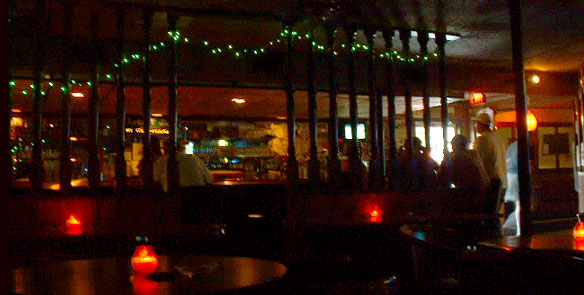
Drinks with John and Scott and Stephanie at a good ol' local bar. The guys are about to go to Europe for the summer. Funky music on the jukebox. Ranging conversations. A jungle guide to Dallas and the Texan artworld. Personal histories traded. A good evening.
Three beers, and I wake up with a headache. Whazzup wit dat? Lightweight.

July 3, 2003
Juno
She's always underfoot.
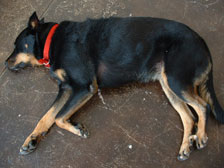
"The Beauceron is a brave, faithful and highly intelligent dog. Fearless, vigilant, and patient, the Beauceron has an aptitude for obedience training and is known for his quick and thorough?understanding of his master's desires. They are an excellent natural guard dog whose appearance and demeanor command respect. The Beauceron is happiest when it is working or exercising in wide-open spaces. They are instinctive herders who will herd everything in sight unless trained to do otherwise. Calm, obedient and very loyal, the Beauceron is always eager to please its master. They like to know who is boss and then they follow. They are generally good with children if they are raised with them from puppyhood, although this large energetic breed can be overwhelming to a small child. Even as a puppy at 3 months old it can weight 40 pounds. The Beauceron can be very protective. Thorough training with a firm master is absolutely necessary. The Beauceron will obey commands from all members of the family if trained to do so. This breed is sociable with dogs they know, but they are highly territorial and will not tolerate an intruder. They should not be left alone for long periods of time. Puppies are very active and slow to mature. The Beauceron should be properly and thoroughly socialized. A Beauceron that has been well socialized and brought up gets along fine under normal circumstances with children, and that also ensures that other dogs and pets will present no problems. They generally get along well with cats if they are introduced to them at an early age."
http://www.dogbreedinfo.com/beauceron.htm
Panel Building Today

OK! I'm building panels today. I have been tooled up, been to the Home Despot and back a couple of times. I wanted to have this done yesterday, it always seems to be this way. It's a little idealism to help me keep it real. A studio visit to occur later today maybe. Drinks tonight with artists John Pomara and Scott Barber, a jungle guide to the local bars.
As the sun burns across the sky, I hope to get a little done in the A/C. I'm listening to KHYI 95.3 "the Range" in and out all day to get into the Dallas frame of mind. (It was the blogger IberianNotes -a Kansan lliving in Barcelona- who flagged the station for me... it's good to know I can listen in later in Tossa) Y'all listen along now:
http://www.khyi.com/
Leverkusen

It was a nice surprise this summer to be included in a nicely articulated group show at Museum Morsbroich Leverkusen. And it especially nice to be in such great company as a personal friend, Pia Fries... not the least of which twenty seven very excellent painters from all over the world. Thanks to Andre Buchmann, my gallery and dealer in Cologne for introducing my work in Europe.
Click on the extended entry for the curatorial essay...
New abstract painting
painting abstract now
Abstraction in new painting
It seems that the duality between abstraction and figuration - which was so important during all the 20th century - no longer holds.
?However, I think that you can use abstract means of getting at a very broad and complex discourse and dealing with thematic issues. And I think, it is still a functional and useful tool, but more of a tool at this point than an end product or a final result.?
This statement of a contemporary New York painter (Jonathan Lasker) gives expression to the old and new interest in abstract painting as an artistic language. Especially during the boom of media-art, fotografie and contextual art in the nineties painting - in particular abstract painting - seemed to be of minor concern in the range of arts.
In comprehensive shows like the both last documentas f.ex. painting was only marginal presented, and what was shown, were mostly figurative concepts.
In fact, the re-arousing interest in painting at the beginning of the new millenium manifests itself in extensive overviews-shows like f.ex. ?Painting on the move? (Basel 2002) , but especially there was obviously missing the very young generation, which is dealing with abstract painterly concepts. Also current presentations and actual publications like ?DeutscheMalereizweitausendunddrei? (Frankfurt, 2003) or ?Vitamin P. New perspectives in painting? (2002) put other main emphasis.
This show, which will take place in Museum Morsbroich Leverkusen in summer 2003 puts the focus on the different manifestations of todays abstraction and its
actual relevance. It shows current painterly positions, which emerge out of the fundamentals of minimal and conceptual painting, and bring in sovereignly new, unused solutions full of emotionality, artistic energy and intellectual intensity.
It also integrates painterly concepts, where the abstraction shows up nearly like a ?fragment?, or is building the painterly landscape on the canvas in combination with figurative elements and connects in this way to the project of modernism and bring forth fresh images, which could be felt as equivalent values to our time.
From the total view of the show in Leverkusen results an overall picture, which shows abstraction as an open and complex instrument, whose relevance in the context of all the other artforms is unbroken and at which starts especially today new fascination.
The show is taking place at Museum Morsbroich Leverkusen from June 1th until
until September 28th 2003.
A catalogue will be published, the show is curated by Ute Riese.
Participating artists:
Fiona Rae
Jonathan Lasker
Fabian Marcaccio
Franz Ackermann
Philip Taaffe
Sarah Morris
Juan Usl?
Olav Christopher Jenssen
Robert Zandvliet
Bernard Frize
Daniel Richter
Lori Hersberger
Katharina Grosse
Jacqueline Humphries
Michael Burges
Christoph Wedding
Michael Stubbs
Dennis Hollingsworth
Frank Nitsche
Stefan Hirsig
Pia Fries
DJ Simpson
Sergej Jensen
Ross Bleckner
David Reed
Stephan Jung
Gary Hume
Peter Zimmermann
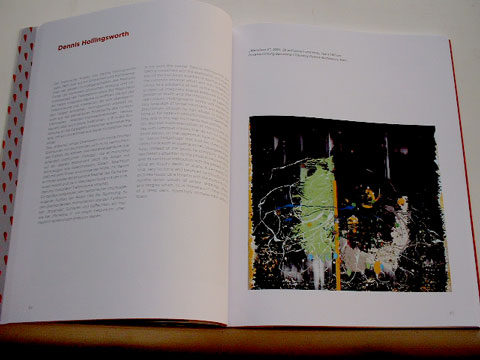
July 2, 2003
Tossa de Mar
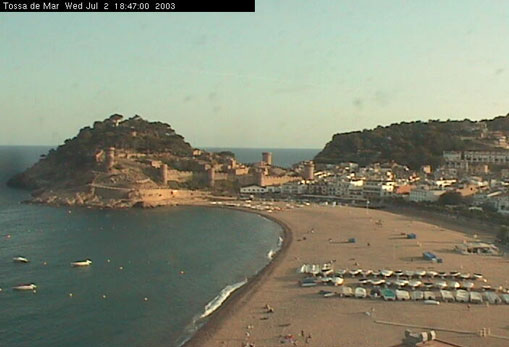
Ah, Tossa!
This is an image dragged from the Tossa municipal live cam, which is available at :
http://www.tossademar.com/ajuntament/webcam/webcambo.htm
Our house is just off the screen to the right hand side. It's summer and the temperature there at the moment is 81 degrees in the early evening. I'm trying to call my Mom, and her line is busy. Maybe she's in a nearby town like she planned earlier, shopping for more antiques? Hello Anna y Josep, Joan y Rosa! Como Estas?
Here, Now.
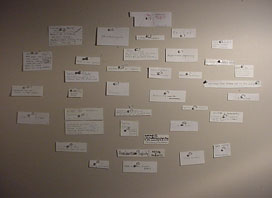
This weblog is an incarnation of an earlier effort I called "The Butterfly Collection". That was in the ChinaTown Studio, sometime between 2000 and 2002. As I would work in the studio, thoughts would arise outside of the framework that initiated the particular painting at hand or of the wet on wet efforts as a whole. Generally, they were ruminations about the way I was painting... as a matter of fact, "Ruminations" was the title of a book I put together when I wasn a young architecture student back in 1984-5. So I guess this is an ongoing concern.
As the thoughts would arise, I would write them down on a small piece of paper and pin them on the wall. One after another, a cluster formed like a butterfly collection. The brutality of it bears a remark or two. There is a suggestion that it was way to "kill" the thought, to put it away. Or, to "kill it with kindness", an act of homage that inters, to keep the mental insect from fluttering round so. A small but beautiful distraction.
By doing so, I could return to the painting itself, rather than hover over it in the clouds. I could return to the fact of the paint at hand... Here,Now. And I could keep the thought, because without pinning the insects on the wall, they would flutter away irretrievable. My hope was to gather the cluster of thoughts and plot their intersections, to discover what I was thinking on the meta scale, there and then.
*****************
Here, Now.
Introduction:
Over the past few months (12-00 to 7-01), I've been pinning up little notes on the wall as successive thoughts crystallize as I work on the paintings. They seem like a butterfly collection. (Am I killing them as I cherish them?) After I sent the work off, I pulled them down and sorted them into like categories, mulling over their significance.
From time to time, people would ask me what I was thinking as I painted. The question seemed to be a combination of incredulity that anything could be thought coherently in the making of these impasto things, and a compliment anticipating a systematic world view. I believe that I don?t work from such a deterministic point of view, that I jumped into alla prima painting as a critique of art that is too figured out beforehand, that is overly constructed in terms of the relation of form to meaning. As to my relation to the world of ideas, I want to indulge my curiosities, but when I go into the studio, I want to get lost in the medium of painting. Eyes agog, a wonderland.
As I look at my work, thought arise, like cargo bobbing up from the depths. I would write them onto scraps of paper and pin them on the wall I start to draw connections but I don?t want to go too far... I just want to flush them out a little here. It's a funny, strange thing to do and it feels good. I'm taking my time, relishing it. It's almost as if this is the very best moment, an immanence.
Clouds fat, heavy and dark.
What follows is rough categorization of ideas, sorted according to likeness. The title underlined is a summary indicate by Roman Numerals in a random order. The butterflies are listed in equally random sequence a., b., c., etc. A short exegesis will follow. This is yet incomplete.
I. The Touch
a Restraint/ Resistance
The little that is done while there is a capacity to do more.
Each mark is a resistance, a fragment of a larger stroke.
b. Shivering.
To shiver the paint onto the surface
(a trembling hand)
A loaded brush touches the surface, but you only need a portion of its? power to do the job. Sometimes you can slow down radically, gathering much information about what?s happening on the picture plane.
In the theater of my imagination, I conjure the image of a trembling hand over the canvas, shivering the paint to the surface. The fingers flicker over the surface, paint wisped and smeared, teased and flung.
II. The Edit
a. A culmination of successive mitigations.
b. Unpainting- untouching
Painting with the part of the mark which is as untouched as
possible.
c. Frankenstein Virginity (editing and innocence)
Sushi. The mark of paint is like a fish where you slice off all the parts that you don?t want to put in your mouth. Each mark has a great and a not so great aspect. It is possible to edit the less desirable aspects. Each subsequent action can cover the edited portions of the previous ones. Therefore all marks are conjunctive in a chain of linked actions. You could virtually pick up the last one and lift them all off the picture plane. What was that children?s game involving a barrel of toy monkeys?
III. Figuration
a. Figuring, ambivalently.
b. Fugitive Schemata
depiction
c. Sock Puppets of Abstraction
d. (looks like) Skin Diver
coral reefs of my childhood, details, hovering, suspended,
aware of breathing
e. Real Time Funky Mondrian
f. Polyp
(just barely), liminal image (organico)
g. Skulls (death is near)
?Oh Death? -Ralph Stanley
A phrenology of form, (recent paintings are portraits).
The originating epiphany mentioned above (wet brush, wet field) occurred while rendering a figure. Marks are made as gesture, line and form according to a figural schema and presto!, an image is represented on the picture plane. One moment they are marks, material... then the concrete substance disappears into the imagination. I want the motivating power of figuration, but not the eclipse of the material. If figuration can be thought of as an automobile, then I fancy myself to be removing the engines to power an abstract project.
IV. Devotion
a. piety
a clipping from the newspaper (LA Times, date lost), an interview with the actor Willem Dafoe ?For an actor, giving over to something that feels outside of yourself is the purest kind of performance.?
b. Deep Studio, Submergence
Studio practice as a meditation, artwork as a mantra
Nearly everything I can think to write about this topic sounds cliched and yet the imperative is undiminished. There?s something better below the crust of platitude. There is something in the devotional attitude that helps to bring out something in oneself that exceeds expectations. To give oneself over to something bigger seems empower even if that source of strength might be illusory. Perhaps the mechanism is not so much about a grand submission to a conventional godhead, but a mundane act of displacement, like seeing with peripheral vision.
Lost in wonderland, there are loners in my family line. It?s a free fall in private space. Picasso painted in the wee hours of the morning. I remember the words of an old friend, Troy Sizemore: ?It?s like fishing.? It?s a form of waiting by abandoning expectations.
When I was eighteen, I enrolled into Transcendental Meditation. The routine is as follows: mantra, stray thought, mantra, stray thought, mantra, stray thought, mantra... if you can do this, you can find yourself in a moment divorced from time (no kidding) where you are acutely aware and your mind seeks no refuge in stray thought nor mantra. Athletes do it. Actors do it. Books have been written about ?flow?.
I haven?t read them.
V. Organizations of Form
a. Arabesque in debris.
b. A formal mathematics.
Auto relational
c. Object Oriented Programming (Newton MessagePad)
text as object
Sometimes people ask if I fabricate the ?objects? and assemble them on the canvas. No, everything is done more or less traditionally on canvas with wet paint. In figurative terms, though, I do import objects to the picture plane. Each application of paint has its? own formal address. They are each fragile, inter-nested and constructed, owing to the physics of impact, displacement and deformation.
In my favorite handheld computer, an Apple Newton MessagePad 2100, the text is manipulatable via a touch screen. The programming is called object oriented. I imagine it's because each word is a movable object rather than each character. I see these two forms of computer programming as something like the relation between my painting and earlier (brush dominated) alla prima painting.
VI. Beauty, Loveliness
a. A Plural Beauty
Beauty of the multifaceted, entanglement, the manifold.
Beauty of God in every-thing
b. Earth rise, earth as a planetary view
A fractile beauty, close up vs distance approach to viewing paintings. Paint as nature, paint as living material.
The beauty of earth as seen from space is a fractile beauty with structures which are lovely when seen at any distance. Fractiles are simply a mathematical expression for geometries found in nature, as opposed to geometries which are implied by nature, but not actually found there. The sun is not a sphere, rather spheres conjure the sun. Similarly, beauty can be said to be about the temporal world, about here, now. Is it possible that beauty is not Platonic? Is beauty found both in the description of waveform (amplitude versus wavelength) and in the lap of the ocean upon a shore? Are they even the same in the name called beauty?
VII. Abstraction as 1. ?concrete physicality and 2. as chaos
a. Phantasmagoria
?We tell ourselves stories in order to live... we look for the sermon in the suicide, for the social or moral lesson in the murder of five. We interpret what we see, select the most workable of the multiple choices. We live entirely, especially if we are writers, by the imposition of the narrative line upon disparate images, by the ?ideas? with which we have learned to freeze the shifting phantasmagoria which is our actual experience.? - Joan Didion, The White Album
b. In a blurring vision, wiping the eyes to see.
c. Lao Tzu, first section, Tao Te Ching.
d. Carnality, Carne, Carnal.
e. Facts on the Ground (USA Presidential Election, 2000)
f. Tissue Cultures
I remember once my buddy Jim buried a cat, recently deceased. Actually, he threw a couple of shovels of dirt on it... so finally, a paw stuck out of the soil. The paw stuck in my mind. I drew it. Dessicated, an impressive reach from the grave. A couple of beers, a topic of jokes, teasing as the night wore on. We decided to bury it properly. Absurdly, we overdug a pit deeper than the tallest among us: Robin, "who lives for longness". It took all night.
Later, we went to Tijuana for carnitas.
VIII. Between-ness, Duality, Half Breed
a. Concretion and Representation
A tension between representation and the thing-ness of paint.
b. Equatorial.
To play on the equator between substance and image.
c. Apogee, Zenith... elementary physics, the cannonball
The parabolic curve, x axis: object vs image, y axis(?)
d. State of Grace
An accumulation of actions where each possesses sacred and profane aspects.
e. Unconscious and self-concious in equal measure.
f. Strangeness
Make it strange and curiosity may persist.
Ambivalence: two windows which open in contrary directions. Janus.
I'm a mongrel. We are all mongrels.
IX. Disruption
a. Audacity, which requires a normative state of affairs
b. Recklessness, then restraint, reflection.
c. A decisiveness that dribbles out in fits and starts.
d. Extremely Conditional
e. Post Facto, Pre Facto.
The experience going in is different from the other side.
f. Order and disruption.
(genetics)
Life, and the primordial soup.
g. The Martial Arts. Painting as combat.
1.Methods of disruption (spontaneous)
2....become ordered..
3....requiring further disruption.
h. Make a pattern, break a pattern.
Make a plan. Break it. Repeat.
Status Quo, Revolution.
A battlefield
as in chess, a field of agents deployed in a territory of contest
Fencing, combat as the detection and subversion of pattern and habit. A detective?s modus operandi. Make a pattern, break a pattern. Deception.
Assets lost and gained, a sub text of peril, mortality, a gnashing of teeth. My father on the Korean War: "You had to become a monster to survive."
Studio/Life
I spent most of the morning answering an email from a young artist.
And now I come to the issue of what to include in this weblog. I asked the young artist for a promise to keep our communications confidential, so I am concerned about keeping this information tight.
I want this blog to be a narrowcast, not a broadcast. I want to give access only to close friends, the galleries I work with and selected collectors. I was happy to work around the conventions of the web: the multiple interlinked domains, the efforts to raise ones' profile in search engine queries, and the like. I want to use technology to make the world smaller, especially since my wife and I are effecting a move to settle in both the Costa Brava and Southern California.
But rather than dump everything here at once, I think I'll boil my water like cooking frogs: a little at a time. Maybe someday, this can be fully transparent.... but for now, poco a poco.
July 1, 2003
Here We Go, Here We Go... (DIE BITCH)
So, my good buddy Dean Terry has set me up with a new fangled toy...
No, not a toy, a tool. You see, I wanted to use the web to connect to my pals worldwide. We are traveling, now in Dallas... once in Los Angeles, tommorrow in Tossa... and even laters in Tossa/LA. It's a big story, and I'll fill you in later as we go along. Right now, I want to insert some recent artifacts.
In this case, here's a little ditty I titled "DIE BITCH". It was an essay written on the eave of our departure from Los Angeles last March. The title sounds rough, but you'll see, it fits just about right.
(PS: the guy in the picture above is my friend and photographer, Tony Cu?ha)
***************
DIE BITCH
I used to have this great studio. It was so, so good. I would literally pause each day and thank God for the blessing. I would stop, pause and simply became aware of his blessing and presence. Now, I'm not religious or anything. I was baptized Catholic even though my dad was brought up Baptist. But my folks weren't especially devout. When I was high school, I tunneled through the library stacks in the art section, then philosophy, then psychology, then religion. I've always thought that God was so good that it wouldn't be a big deal if I passed on guessing in this life which religious shell the holy pea was hid under. I just had to just be there, with God... and say thanks.
But I swear, this studio was the best ever. It was in Los Angeles, ChinaTown. It was an old banquet room for a hipster restaurant in the fifties. It looked like the set of "The King and I", and there I was, a veritable Yule Brenner, dancing in ecstatic circles every day. The stage was elevated and sheltered under a mock village roof of fired yellow glazed clay tiles. There was a central skylight that was immense and it had a stained glass lens that resembled a huge flower in reds and green. The ceiling was curved in a draping soffit of wood in the four cardinal directions away from the central skylight to the perimeter walls. Bamboo used to grow around in a perimeter planter strip, the shoots now gone. Another skylight lined the edge of an eastern interior wall, and right after noon, the sunlight would rake the wall. That was perfect for my paintings because they were impasto, painted alla prima, and the low relief of the pigmented material was made dramatic and rich in saturated in full angled sunlight.
I was lucky too, that my art making sustained itself and I could paint all day and night. And because I painted wet into wet, I had to make hay whilst the paint was pliable, often painting in twelve, twenty four or more hour stretches. When I got tired, I would sit on the edge of the stage and lay back on a mat. From that vantage point, I could see the fabulous big bellies of the curving ceiling and radiant skylight. The wood surface made me think of boats, like I was underwater. I would lay there, immersed in the problem and joy of painting, with my rising and dropping energy levels floating me into and out of consciousness. All with this veritable mandala in my ceiling.
Yea, I'm a cat napper. What's the difference between twenty minutes at two in the morning or twenty at eleven? Art for me is the dissolve between work and play, so too did the clock dissolve as well. Louis Kahn used to be cat napper too, on a mat in the corner of his office. You know, the great L. Kahn, the architect from Philadelphia. Unique and immortal. I'm in good company, so there. I read that he died in a toilet stall in a New York subway, returning from India. It would have been better to finally go out of consciousness with the image of my Chinese ceiling instead of toilet stall graffiti and your pants down around your legs.
Thank you, God. Thanks for the years of beautiful moments.
But there was more. This gift from God was situated in ChinaTown, a real pedestrian community in a city of cars that didn?t deserve such a place. When I first got the studio, it was abandoned for twenty-five years. It took six stake bedded truckloads of trash to clear it out. The neighborhood was in a similar state of decline, perfect for artists. The city forgot about that neighborhood. Rent was low and people like me could afford to spend time thinking about art. It enfronted an alley called Bamboo Lane, no less. And what made it better, it wasn't really a city street but a private way. Nothing was made to city regulation specs. Sidewalks were ridiculously narrow, and people parked like idiots, and it was all ok. There was an Dim Sum place, an old family antique store and a bakery next to me. People would double park all day long, to maneuver their cakes into the cars, happy times exported all over the city right from that location.
And There was more! There was a computer gaming place right around the corner. It was created by these two Asian kids for their friends. This the classic story of the maturation, matriculation and deliverance from the street creed. I won't get into the details. I watched the owners Dave and Sonny put this place together from scratch and I'm proud of them. I would (ahem) take a break and play for no more than an hour per day/every other day or two. The kids would play for hours, I would guess an average of four to six hours at a time. And if you think they were wasting their time, remember that this was the kind of activity that contributed to the lower friendly fire and civilian casualty rates in Afghanistan recently. Do the research and see for yourself. At any rate, I think this is a precursor art form, like silent films were to contemporary movies and television. Already, I've heard of games being bundled with action movies. It's easy to imagine a movie as a game with this type, where the story would take a second position to the setting. Stories would become incipient, and variable, even fugal.
They hooked up a limited area network (LAN) and plugged it all into the internet with a ultra high speed connection. They played games, and the one that had everyone's attention was the one called "Counter-Strike". It was modified from a commercially available game called "Half Life" free of charge, open source style. It was created by amateurs and it was propagated by enthusiasts. There was no career idea, no commercial motive. Communities spread like wildfire, spontaneously through the net. The game program provided the simulated environment and we played within it through avatars: terrorists and counter terrorists. The simulated environments were called ?maps? and there were about fifty or more maps available. Las Vegas, a nuclear container in a train yard, a chateau, a high rise under construction, an airport, a dusty town in the MidEast. Bad guys placed bombs and good guys defused them whilst the two sides blasted each other away ferociously.
I mean ferociously. Each game would have about a five minute time limit, a long time when you are trying to kill a deadly adversary. The round would begin with the spawning of the players at opposite ends of the map, the bomb site is indicated by spray painted graffiti. After the early months of game mayhem, people began teaming up spontaneously. They called themselves Clans. They were deadly. One clan called itself "KGB", so a team member might be called "KGB-Snoopy". One group was called the "Seven Dwarfs". "Sleepy" was the king, harvesting three or four times as many kills as the average player. You know you were good when they accused you of cheating, employing hacks to improve your aim, for example. They would say: "It's all about the skills, homie". Indeed it is.
The immersion into the virtual environment was so total that the interface of keyboard and mouse vanished and one had a vivid feeling of the immediate reality of that place. You... are... there. The sound was three dimensional. You could hear the boots grind around the corner, if you stopped to listen. At first, it could make you dizzy. But then the imperative of saving your ass kicks in as your opponents close in on you. Then your mind leads the action on the screen and presto!, you are really there, for all practical purposes. A frickin' Hobbesian practical purpose with (virtual) teeth. Adrenaline addicts, that's what we are.
It's like basket ball, especially when we would play in the same map repeatedly. After a while, we would get to know the map intimately and calculate the limited number of variables described by the three dimensional spaces/places. Every action delimited and truncated all subsequent actions. This is a martial art, full-on. The basic rule is make a pattern, break a pattern. You find what pattern your opponent is habituated to and you disrupt it. And your opponent was not a program, it was a real person and that person could be in the room with you, or on another continent, in real time. Talk about a smaller world. It wasn't unusual to read their text messages in German, Spanish, Vietnamese or anything else.
The span of a lifetime is made smaller, too. Age doesn?t matter. Most of the kids were in their late teens. In the afternoon, when school was out, the place was lousy with kids. Some so young, I would marvel at how their hands could spread to hit the keys. And some of those little babies are very formidable inside the game. Ruthless. Counter-Strike levels, it didn't recognize age, just skills. But mostly, there were the regulars, older kids in their late teens, early twenties who would plow hours in there. I couldn?t match them in the skill building, forget it. I would limit myself to an hour, sometimes two on special occasions, and rarely more, once in a great while. Honest.
The kids would take on screen names like "BiGDiCKBaSTaRD?, or DONTSHOOTMEIMAGuRL", or "ARSON", or image-names like "<======[]=+". My name was RINGO. Like I had mentioned, they could communicate via text messages on the corner of the screen, and the banter was wild, sometimes nasty, always flashing identity, full of cocky attitude like Cassius Clay. Bravado. Sometimes, they would ask my age. I would tap it in. 46. Silence would follow in what I would take to be astonishment. Well, why the hell not? Rarely, once a year, someone (Mr. Punk, I assume?) would get in my face. I would play it real flat like, deadpan... that would defuse the tension. Just doin' my job, man. My favorite screen name was someone who called himself "DIE BITCH". Brilliant. When you died in the game, your opponent's name would appear in the center of the screen. This kid's name would grace your demise with the those incisive words, all mocking attitude and disdain. A challenge to do better.
And there was more still. My previous studio was a fifteen minute walk from my home, but I ended up driving all the time anyway, to get lunch or run errands. Restaurants and bars were all over ChinaTown. Artists too. Rent was good (not cheap) four years ago. I have this theory. the artworld is like an aquarium. It needs the requisite components to sustain a lifeworld: water, gravel, bottom feeders, top feeders, plants, bubbles... and therefore, an artworld needs artists (yea, I have to say it, lest ye forget), naive galleries, ?sophisticated? galleries, critics, publications, collectors, museums... Artists need time to think, time to nurture some thing/activity for it's own sake, time to be able to be the first audience for the manifestation of something so good that others may notice and join in on the party. Therefore, rent has to be cheap. Johns and Rauchenberg paid twenty five dollars a month for entire floors of buildings in young SoHo. Picasso had bohemian Montmartre. ChinaTown.
There were a lot of artists within walking distance. They were of all kinds: bottom feeders, top feeders. Most were real, not bullshit lifestylers, making the crazy gamble that their nucleus of an audience will dilate in time sufficiently to curb an early death and wretched privation. There were many late night crits and dishing the artworld around a cup of coffee. There were cool bars there, too. One was in the base of a pagoda that was a marker in town. Art was never really talked about directly there. People talked about sports, or politics or the gnashing of the various personalities. Art was a subtext for a social eddy where some would cruise, art-professional style, and others would play dead pan. Another bar is set to open soon, called the "Mountain", owned by a troika of genial guys. It is sure to attract the all the art sharks in black leather jackets as well as few sardines like me. I won't be there for that.
There was no cultural displacement. There was plenty of anticipation of it. The local Chinese residents, businesses and property owners got along with the new artist population seamlessly. There was a symbiosis, a complementariness. One gallery even gave my 82 year old landlady a show, capturing via installation, her curio shop on the occassion of her retirement. It was simultaneously a classic appropriation, and a simple act of kindness, a neighborly homage. Brilliant.
I'm leaving town. I'm not going because of the cycle of gentrification: artist as pioneer, the early adopter, a force for urban change and evolution. Although I like the moniker of one who was part of vital beginnings, I didn't plan it that way. I just wanted cheaper rent. I'm leaving town for important, personal reasons... not because of the strange hard edge that belies the dreamscape of Los Angeles. I heard once that a traffic accident in San Diego versus one in Los Angeles differs in that the former was one where the participants would tend to work it out privately and the ones here would engage their lawyers. That?s a good rough sketch of LA. ChinaTown was a place where the people (artists and the Asian locals) would work things out privately, with various levels of heat and light. There was plenty of drama. Property owners getting defensive, reporters looking for cliches, young kids fucking like minks, babies were born. One young artist even totally flipped out (rubber room style), the police had to shoot him seven times with bean bags whilst he stripped naked. He shit in his hands and smeared his body brown. Another died from an overdose. And now, the lawyers are moving in. They are the ones who seek the artist lifestyle. Who can blame them? I certainly like it sure enough. The only trouble is they are a million miles away from art.
I'm leaving not because Los Angeles is a hard assed town and an Elysium tambien. I'm not leaving because the social circles are only as big as the number of people one can bar-b-que for in the back yard. I'm not leaving because the movies "ChinaTown" and "The Day of the Locust" are spot-on accurate. I'm not leaving because John Fante nailed the city when he wrote: "...you pretty town I loved you so much, you sad flower in the sand, you pretty town ...". I'm not leaving because this metroplex is simultaneously parochial and international... and yet finally, parochial. This is LA with all its' mocking attitude and disdain, a challenge to do better.
I was a "military brat" growing up, moving constantly. So when I got out of college, I settled into Los Angeles to make it my home, one I never had. And to my surprise, I never developed a tap root... they spread out horizontally instead, in this desert soil by the sea. And now I... and my little family, will travel horizontally. It's too big a story to tell here. We're keeping our house and we're renting it out to good, nurturing people. That means that we aren't really leaving in a fundamental sense. We're moving, but we're not moving away. We'll be back someday when we can, after this grand adventure to unfold.
And now, music is playing in my head, the refrain of a song in the musical "Gospel at Colonus":
"...Live!
While you can!
Be happy!
While you can!
Happier than God has made your father
Live!
While you can!
Be happy!
While you can!
You might not be here tomorrow..."
-by Ringo
Spring 2003
Here I am in my Dallas Studio,
Trying to connect with my pals worldwide
Trying
Trying
Trying....
first time
thanks, Dean for this gift
spaces
lines
spaces
and mini fake paragraphs
junk in there
more stuff
more stuff
A tribute to my pal, Dean
Thank you Dean
Thank you thank you thank you
Thank you very much...
With this, I shall use for good and not evil.
